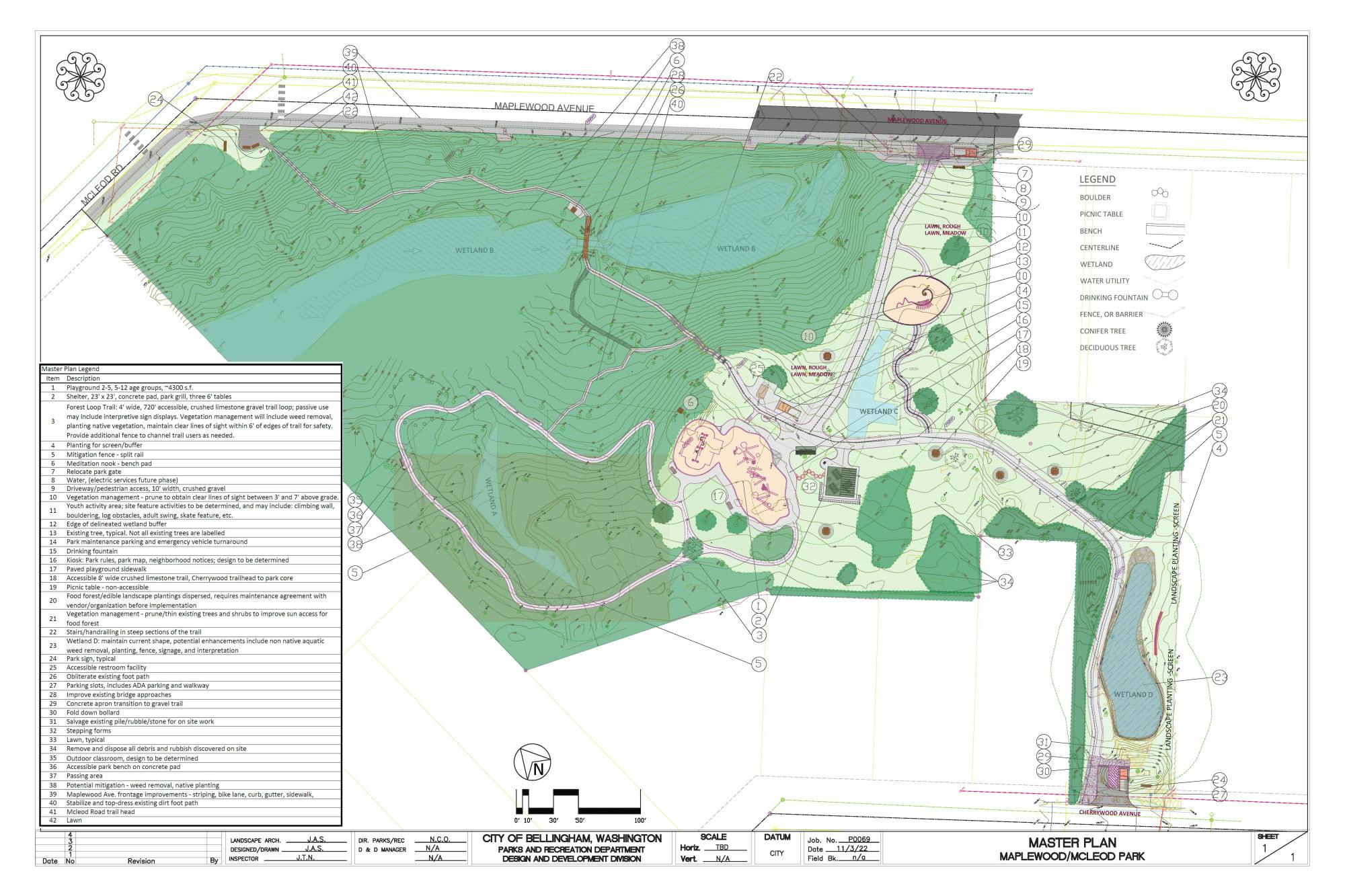Bellingham City Council approved the Parks and Recreation department’s motion to apply for a $500,000 grant from the Washington State Recreation and Conservation Office to add to the Storybrook Phase One budget, which is estimated to be $1,818,054.
Phase One park development is estimated to cost around $2.1 million, and this grant will be matched with park impact fee funds. Real estate excise tax funds will fund the street frontage improvements.
The plot of land to receive the makeover is a space sandwiched between Cherrywood Avenue and West Maplewood Avenue. The land is unkempt, and consists currently of just a walking trail from West Maplewood to Cherrywood Avenue.
Phase One plans include features such as an age-separated playground meeting both safety and ADA requirements, park trails connecting from Cherrywood Avenue, a forest loop trail including an outdoor classroom and a trail/emergency access from West Maplewood Avenue.
Park features will include benches, picnic tables, trash receptacles, dog-waste stations, a drinking fountain, a hose bib, gates, fences and other barriers, and lighting. Additionally, park-name signs, wayfinding posts and a community kiosk are included in the development plan.
“We applaud [Parks and Recreation]'s staff efforts to create places for play with the playground for preschool and school-age kids,” Todd Elsworth, Executive Director of Recreation Northwest, said.

The Storybrook master plan. This will take the place of what is currently called Maplewood/Mcleod Park in the Birchwood neighborhood. // Plan courtesy of Bellingham Parks & Recreation
There’s an imbalance of parks in north Bellingham compared to south Bellingham. Elsworth addressed this in a letter he wrote to Washington State RCO in support of Parks and Recreation applying for the RCO grant.
“Our residents recognize that we have had an imbalance of parklands between north and south and we appreciate the city actively working to balance the scales. We see great potential in the plans that are laid out in the first stage of development for Storybook Park,” Elsworth said in a letter to Washington State RCO.
A big concern of Sarah Gardner's, president of the Birchwood Neighborhood Association, is accessibility on West Maplewood Avenue.
“There’s a concentration of large, multi-family housing units within walking distance to the park, and we need to improve the sidewalk and accessibility of the park so kids can get there safely and independently,” Gardner said.
The plan is to construct bike and pedestrian improvements such as a bike lane, sidewalk, parking, utility and mailbox relocation, and to cut trees and reduce certain driveways. This will be funded by the real estate excise tax funds.
The Phase Two plans will continue to add features, including a food forest where park goers can pick fresh food from native plants, and an activity area intended for youth and young adults that could include either a rock wall or a skateboarding feature.

Storybrook Phase 1 will focus on a children’s play area, a water fountain, an outdoor classroom, a forest loop trail and improving existing trails as well as other features. // Plan courtesy of Bellingham Parks & Recreation
Preparations for the park renovation have been in the works since March 2022, including extensive public input.
“The process starts with a need,” Landscape Architect for Bellingham Parks and Recreation Jonathan Schilk said. “What’s the need in this regard?”
The Birchwood neighborhood faces a variety of obstacles, according to Schilk. It's the fifth most densely populated neighborhood and most people don’t have any outdoor recreation in their vicinity, he said.
As of right now, all that exists in the area is a walking path, and it isn’t the well rounded recreation experience that Bellingham Parks and Recreation wants to provide this neighborhood, Schilk explained.
“The city has identified Storybrook Park as a high priority need,” Schilk said.
A big focus for the neighborhood association is to have park features that will attract teens and young adults.
“Birchwood is an underserved community. We need to take into consideration, when designing parks, that essential infrastructure is needed to foster healthy intervention in the lives of at-risk and marginalized youth,” Joy Patterson, vice president of the Birchwood Neighborhood Association, said in the proposal for Storybrook Park.

A meadow in the current Maplewood/Mcleod Park area in Bellingham, Wash., on May 3, 2024. The forest loop trail will begin approximately between the two trees in the center of the photo. // Photo by Nathan Barber
Storybrook is 72% encumbered by critical environmental areas and features four delineated wetlands, leaving approximately 1.6 out of the 5.77 total acres to work with where buffer mitigation is not a constraint.
Wetlands are defined by category numbers. This ranges from category one which is highly functioning to category four which has minimum function. Wetlands play important roles in managing runoff and pollution in surface waters.
The category the wetland is assigned determines the size of the mitigation buffer zone. The higher functioning wetlands get larger buffer zones. According to Schilk, you can still build in these buffer zones but you must make up for the loss of function, which means that any trees that are cut down must be replanted after construction ends.
A feature of the park that will likely have to wait until Phase Two is the food forest. The need for the food forest stems from Birchwood's status as a food desert due to a lack of grocery stores in the area, Schilk explained.
A challenge with implementing the food forest is finding people who will maintain it. A community garden was considered by Gardner, but the space doesn’t receive enough direct sunlight to support it.
Construction for Phase One is anticipated to last from May 2024 through December 2024.
Nathan Barber is in his third year at Western and will be majoring in Visual Journalism. He’s an avid kitty cat enthusiast. You can usually find him either on Mount Baker during the weekends, or at the skate park in downtown Bellingham during the week. Reach him at nathanbarber.thefront@gmail.com.






